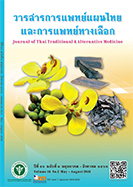The Effect of Head Massage on Electromyography Biofeedback,Blood Pressure and Heart Rates in Massage Therapists
Main Article Content
Abstract
การวิจัยนี้มีวัตถุประสงค์เพื่อศึกษาผลของการนวดศีรษะต่อการให้ข้อมูลย้อนกลับของคลื่นไฟฟ้ากล้ามเนื้อ ความดันโลหิตและอัตราการเต้นของหัวใจ ผู้เข้าร่วมวิจัยเป็นพนักงานนวดที่ทำงานประจำ มีอายุระหว่าง 30–50 ปี จํานวน 16 คน ได้มาจากการสุ่มแบบเฉพาะเจาะจง คือ เป็นผู้ที่ไม่มีประวัติการบาดเจ็บของกล้ามเนื้อหลังและคอ อาการปวดศีรษะรุนแรง อาการปวดศีรษะเรื้อรัง และยินยอมเข้าร่วมตลอดจนสิ้นสุดการวิจัย มีอายุเฉลี่ย 40.5 ± 8.91 ปี น้ำหนัก 58.4 ± 8.87 กิโลกรัม ส่วนสูง 157.3 ± 3.56 เซนติเมตร ชั่วโมงการทำงาน 32.2 ± 2.74 ชั่วโมง และประสบการณ์การทำงาน 25.8 ± 21.83 เดือน ในการทดลองจะให้ กลุ่มตัวอย่างได้รับการนวดศีรษะด้วยเทคนิคการนวดศีรษะแบบอินเดีย (Shirobhyanga) ใช้เวลาในการนวด 60 นาที ประกอบไปด้วยการนวดศีรษะในท่านอนหงายและกดจุดบริเวณด้านหน้าเป็นระยะเวลา 30 นาที และการนวดศีรษะในท่านอนคว่ำ นวดคอและหลังรวมทั้งกดจุด เป็นระยะเวลา 30 นาที ตัวแปรที่ใช้ในการศึกษาครั้งนี้ คือ การให้ข้อมูลย้อนกลับของคลื่นไฟฟ้ากล้ามเนื้อ ความดันโลหิต และอัตราการเต้นหัวใจ โดยทําการวัดในช่วงเวลาต่าง ๆ คือ ก่อนการนวด ระหว่างการนวดนาทีที่ 30 และสิ้นสุดการนวดนาทีที่ 60 วิเคราะห์ข้อมูลด้วยการวิเคราะห์ความแปรปรวนทางเดียวแบบวัดซ้ำ โดยกําหนดความมีนัยสําคัญทางสถิติที่ระดับ 0.05 ผลการวิจัยพบว่า เมื่อทำการเปรียบเทียบทั้ง 3 ช่วงเวลา ได้แก่ ก่อนการนวด ระหว่างการนวด และหลังการนวดศีรษะ โดยทำการวัดการให้ข้อมูลย้อนกลับของคลื่นไฟฟ้ากล้ามเนื้อ อัตราการเต้นของหัวใจ ความดันซิสโตลิก พบว่า มีค่าลดลงอย่างมีนัยสำคัญทางสถิติ (p = 0.000) แต่ความดันไดแอสโตลิกมีแนวโน้มลดลงแต่ไม่มีความแตกต่างกัน (p = 0.507) แสดงให้เห็นว่าการนวดศีรษะด้วยเทคนิคการนวดแบบอินเดียส่งผลให้ร่างกายเกิดการผ่อนคลายมากขึ้น
Article Details
References
2. Perke M. Evaluation of role of shirobhyanga with reference to kesha swasthya. International Research Journal of Pharmacy. 2013;4(3):125-7.
3. Thomas HB, Johann MS, Charles SA, Daniel JM. EMG biofeedback and tension headache: a controlled outcome study. Psychosomatic Medicine. 1973;35(6):484-96.
4. Wilmore JH, Costil DL, Kenney LW. Physiology of sport and exercise. 4th ed: Human Kinetics Publishers; 2008. 574 p.
5. Monedero J, Donne B. Effect of recovery interventions on lactate removal and subsequent performance. Int J Sports Med. 2000;21:593-7.
6. Robert A, Ghiasvand F, Parker D. Biochemistry of exercise-induced metabolic acidosis. Am J Physiol Regul Integr Comp Physiol. 2004;287:R502-16.
7. Nakamura K, Takahashi H, Srhmai S and Tanaka M. Effect of immersion in tepid bath water on recovery from fatigue after submaximal exercise in man. Ergonomics. 1996;39(2):257-66.
8. Aourell M, Skoog M. and Carleson J. Effects of Swedish massage on blood pressure. Complementary Therapies in Clinical Practice1. 2005;11(4):242-6.
9. Lance D, Dawson A. and Tiidus M. Evaluating the influence of massage on leg strength, swelling and pain following a half-marathon. Journal of Sports Science and Medicine. 2004;3:37-43.
10. Mori H, Ohsawa H, Tanaka H, Taniwaki E, Leisman G, Nishijo K. Effect of massage on blood flow and muscle fatigue following isometric lumbar exercise. Med Sci Monit. 2004;10(5):173-8.
11. Leivadi S, Hernandez M, Field T, O’Rourke M, Arienzo D, Lewis D, et al. Massage therapy and relaxation effects on university dance students. Journal of Dance Medicine and Science. 1999;3:108-12.
12. Diego MA, Field T. Moderate pressure massage elicits a parasympathetic nervous system response. International Journal of Neuroscience. 2009;119(5):630-8.
13. Kim IH, Kim TY, Ko YW. The effect of a scalp massage on stress hormone, blood pressure, and heart rate of healthy female. The Journal of Physical Therapy Science. 2016;28:2703-7
14. Weerapong P, Hume PA, Kolt GS. The mechanisms of massage and effects on performance, muscle recovery and injury prevention. Sports Medicine. 2005;35(3):235-56.


